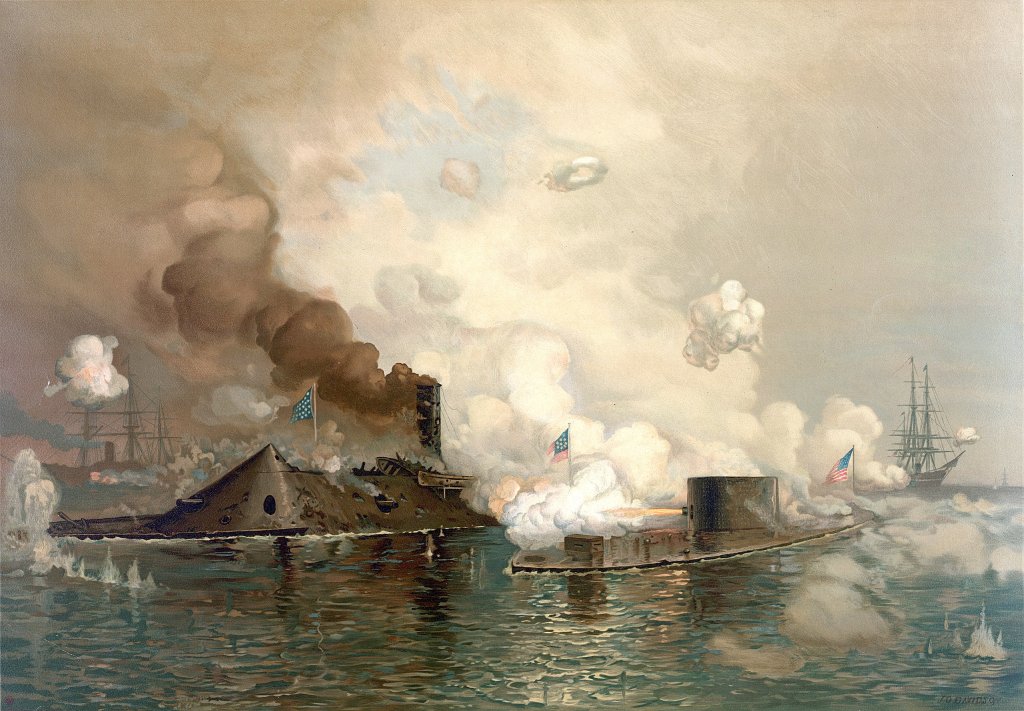

On March 8, 1862, a large, slow-moving and unwieldy Confederate ship steamed toward the blockading Union vessels posted at Hampton Roads, outside of Virginia’s James River. The rebels made a beeline for the sloops USS Cumberland and USS Congress. As the rebel vessel approached, the Cumberland fired into it, but the cannon fire bounced harmlessly off the rebel ship’s ironclad hull.
It was the Confederate ironclad CSS Virginia, and before the day was done, it would ram the Cumberland, sinking it. The Congress would be blown up and sunk and the USS Minnesota would run aground trying to join the attack on the Virginia. It would be the U.S. Navy’s biggest defeat until World War II and threatened to change the balance of power in American waters. The power brokers in Washington panicked. Everyone except Navy Secretary Gideon Welles. He knew the Union had its own armored warship and it was already on its way to take out the CSS Virginia.

When the Civil War started, the Confederate States of America had no navy to speak of. Rebel leaders knew they couldn’t compete with Northern industrial capacity, so their strategy was to build smaller numbers of ships that simply outclassed and outgunned the Union’s ships. To build their first ironclad warship, they raised the USS Merrimack, a wooden ship sunk when Virginia seceded from the Union to keep it out of rebel hands. The Confederacy rebuilt it as an armored, steam-powered warship and rechristened it the CSS Virginia.
It wasn’t long before the Union got wind of the Virginia under construction and began building their own. They turned to the eccentric, Swedish-born John Ericsson. Ericsson was an accomplished inventor who invented propellers, the hot-air engine, critical parts for advanced steam engines, and would later develop guided torpedoes and even a solar-powered engine in 1872. When he presented his design for the U.S. Navy’s first-ever armored warship, USS Monitor, the American press actually laughed at it. But Ericsson would have the last laugh.

The USS Monitor had only two guns, while the Merrimack had 10. The Monitor’s guns, however, were a larger caliber and were mounted on a rotating turret, powered by a steam engine. The Monitor was filled with new technology that Ericsson created just for the ship, with 47 patentable new inventions in all. Monitor was completed before the Virginia, but the Virginia was first to make it into service, wreaking havoc on the Union blockade on March 8, 1862. The rebel ironclad took significant damage in the attack but ruled the seas for the night.
The next day, the Virginia was still completing as many repairs as it could as the Monitor steamed into Hampton Roads. It took up a position to protect the grounded USS Minnesota. Knowing the Minnesota was stuck, it became Virginia’s first target that morning. As the rebel ironclad closed in on its victim, its way was blocked by a strange object. The rebels didn’t even realize the Monitor was a ship at first, but it would soon become an epic seaborne battle.
For hours, the two ships blasted away at each other at so close a range they collided five times. The Monitor couldn’t penetrate the Virginia’s armor because it wasn’t using enough powder charge. The Virginia couldn’t penetrate the Monitor’s armor because it wasn’t using the right ammunition. Virginia would briefly run aground. Monitor’s skipper would be temporarily blinded by incoming rebel fire. Both ships were crewed with sailors who could barely see or hear for all the smoke and cannon fire. After nearly five hours, the rebels were forced to drive off due to heavy damage, returning to Norfolk. The Monitor maintained its position near the Minnesota.

The Battle of Hampton Roads, also known as the Battle of the Monitor and the Merrimack (the Virginia’s original name was never accepted in the Union), was the first-ever meeting between two ironclad warships. The fight was technically a draw, but both sides declared a victory. The Monitor’s helmsman, Peter Williams, was awarded the Medal of Honor for staying at the ship’s wheel for the entirety of the battle. The day the two ships met in combat, every other country’s navy immediately became obsolete.
The Union blockading squadron remained at Hampton Roads while the two ironclads tried to goad each other into another fight. They never met again. In the months that followed, CSS Virginia would be destroyed by the rebels when the Confederates abandoned Norfolk on May 9, 1862. USS Monitor sank in rough water off the coast of North Carolina later that year.
